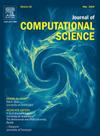从模拟到替代:神经网络增强烧伤创面愈合预测
IF 3.7
3区 计算机科学
Q2 COMPUTER SCIENCE, INTERDISCIPLINARY APPLICATIONS
引用次数: 0
摘要
烧伤会引发严重的炎症,使伤口愈合复杂化,并可能导致严重的全身并发症。了解烧伤的免疫反应对改善治疗至关重要。尽管基于智能体的模型(ABMs)对于研究这些相互作用很有价值,但它们的计算要求很高。本文探讨了神经网络(NNs)作为替代模型的集成,以近似和预测ABM模拟结果,预测细胞因子随时间和空间的浓度。我们使用CompuCell3D软件开发了一个基线ABM,模拟先天免疫反应并生成广泛的细胞因子浓度数据。这些数据被处理并准备用于神经网络训练,包括数据清洗,转换为合适的格式,以及时间序列感知的训练-测试分割。然后我们实现和评估各种神经网络架构。每个模型都旨在捕捉细胞因子浓度的时空动态,并通过调整模型架构(核数、层数、每层神经元)来更好地适应这个问题。使用均方误差、r平方和平均绝对百分比误差对模型进行评估。在本文中,我们评估了不同的神经网络架构(卷积神经网络(cnn),长短期记忆(LSTM)神经网络,注意机制和物理信息神经网络(pinn))如何预测该生物系统中细胞因子的浓度。我们发现STA-LSTM通常在统计指标上表现最好。本文章由计算机程序翻译,如有差异,请以英文原文为准。

From simulations to surrogates: Neural networks enhancing burn wound healing predictions
Burn injuries trigger substantial inflammation, complicating wound healing and potentially leading to severe systemic complications. Understanding the immune response to burns is crucial for improving treatment. Although agent-based models (ABMs) are valuable for studying these interactions, they are computationally demanding. This paper explores the integration of neural networks (NNs) as surrogate models to approximate and forecast ABM simulation results in predicting cytokine concentrations over time and space. We present the development of a baseline ABM using the CompuCell3D software, simulating the innate immune response and generating extensive cytokine concentration data. This data is processed and prepared for neural network training, involving data cleaning, transformation into suitable formats, and a time-series-aware train-test split. We then implement and assess various neural network architectures. Each model is designed to capture the temporal and spatial dynamics of cytokine concentrations, with adjusted model architectures (kernels, number of layers, neurons per layer) to better suit this problem. The models are evaluated using Mean Squared Error, R-squared, and Mean Absolute Percentage Error. In this paper, we assess how different NN architectures (convolutional neural networks (CNNs), long short-term memory (LSTM) neural networks, attention mechanisms, and physics-informed neural networks (PINNs)) predict the concentration of cytokines in this biological system. We find that STA-LSTM generally performs best across statistical metrics.
求助全文
通过发布文献求助,成功后即可免费获取论文全文。
去求助
来源期刊

Journal of Computational Science
COMPUTER SCIENCE, INTERDISCIPLINARY APPLICATIONS-COMPUTER SCIENCE, THEORY & METHODS
CiteScore
5.50
自引率
3.00%
发文量
227
审稿时长
41 days
期刊介绍:
Computational Science is a rapidly growing multi- and interdisciplinary field that uses advanced computing and data analysis to understand and solve complex problems. It has reached a level of predictive capability that now firmly complements the traditional pillars of experimentation and theory.
The recent advances in experimental techniques such as detectors, on-line sensor networks and high-resolution imaging techniques, have opened up new windows into physical and biological processes at many levels of detail. The resulting data explosion allows for detailed data driven modeling and simulation.
This new discipline in science combines computational thinking, modern computational methods, devices and collateral technologies to address problems far beyond the scope of traditional numerical methods.
Computational science typically unifies three distinct elements:
• Modeling, Algorithms and Simulations (e.g. numerical and non-numerical, discrete and continuous);
• Software developed to solve science (e.g., biological, physical, and social), engineering, medicine, and humanities problems;
• Computer and information science that develops and optimizes the advanced system hardware, software, networking, and data management components (e.g. problem solving environments).
 求助内容:
求助内容: 应助结果提醒方式:
应助结果提醒方式:


